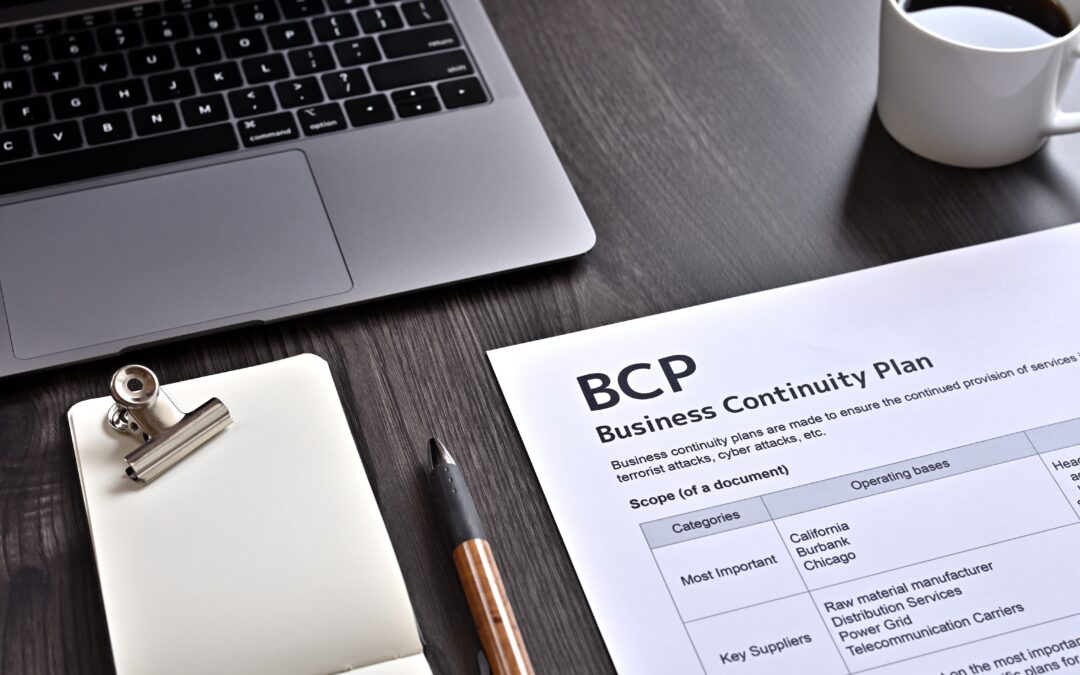In recent years, organizations have faced global health emergency, cyber attacks, climate disasters, and geopolitical shifts. These events have made it clear how quick day-to-day operations can be disrupted—and why planning for these situations is necessary, not optional.
A strong Business Continuity Plan (BCP) acts as a lifeline during disruptions, helping it keep the business running and minimizing downtime during crises.
A BCP identifies an organization’s key operations, assesses the risks to those operations, and outlines strategies to offset the impact of various business disruptions.
The goal? To enable a swift, organized response that safeguards people and assets while maintaining as much business continuity as possible.
Developing Business Continuity Plans for Uncertain Times
Unforeseen events can strike from any direction—whether a sudden internal system failure or a wide-scale external crisis—and the consequences of not being prepared are severe.
Business Continuity Planning is important because it provides a structured approach to keep the business running when the unexpected happens.
Even minor disruptions can have a ripple effect on your business. From financial losses to reputational damage, customer churn, or even regulatory penalties, these consequences aren’t ones you want to risk.
Having a BCP in place helps organizations:
- Minimize downtime and financial loss: With the ability to respond swiftly and keep core operations on track, companies reduce revenue loss during a disruption.
- Protect employees and assets: Plans typically prioritize employee safety and secure critical assets. This can mean having evacuation procedures, backup work sites, or IT fail-safes ready to go.
- Maintain customer trust and reputation: With a BCP, a business can continue serving customers (even at reduced capacity), which helps uphold its brand reputation.
- Avoid chaos and ensure compliance: A straightforward continuity plan assigns roles and responsibilities before a disaster strikes. This avoids confusion during emergency response and ensures critical decisions are made quickly.
In short, a BCP is insurance for your business’s survival. It not only guides immediate crisis response but also promotes long-term resilience, so your organization can weather storms and emerge stable.
Does your business have a critical response team? Here’s why every business needs a CRT.
The 4 P’s of Business Continuity Planning
Another useful way to evaluate your continuity preparedness is by using the “4 P’s” framework: People, Processes, Premises, and Providers.
These are the four key areas any robust business continuity plan should address to ensure the organization can continue operating during and after a disruption:
- People: Your employees are the heart of the business, so their safety and ability to work during a crisis is paramount. This means having emergency communication plans, backup staffing or cross-training for critical roles, and support resources to help staff through the disruption.
- Processes: These are the workflows and functions that keep the business running. Identify which processes are integral to operations and plan how to sustain them when conditions aren’t ideal.
- Premises: Consider the physical locations and infrastructure the business relies on— offices, plants, data centers, warehouses, etc. A continuity plan should address how to protect or substitute these premises if they become unusable.
- Providers: No business operates alone. “Providers” refers to external partners like vendors, suppliers, service providers, and even utilities that your operations depend on.
By covering People, Processes, Premises, and Providers, you reduce the chance that any single point of failure —whether human, operational, physical, or external—will bring your business to a halt.
5 Steps to Develop a Business Continuity Plan
Developing a business continuity plan can be approached in an organized, step-by-step manner.
Here are the five key steps to build an effective BCP for your organization:
1. Conduct a Risk Assessment (TRA)
Begin by identifying the threats that could impact your business and analyzing the risks.
This Threat and Risk Assessment involves brainstorming all plausible scenarios (from cyberattacks to natural disasters) and determining how likely each is to occur and how severely it could affect your operations.
As part of this step, you will often perform a Business Impact Analysis (BIA) to quantify how different outages or disruptions would harm your business (e.g., estimating potential downtime costs or operational delays).
This analysis helps prioritize which risks are most urgent to address.
Don’t miss this article next: Implementing Effective Risk Assessment Frameworks.
2. Develop Business Continuity Strategies
Using the insights from your risk assessment and BIA, the next step is to formulate strategies and plans to handle those identified risks and impacts.
Effectively, for each major threat, ask “how will our business cope with this?”
This step involves designing the practical arrangements that make up your continuity plan. This could be setting up data backups and recovery procedures, creating work-from-home policies, arranging backup production facilities, or establishing an emergency communication tree.
The output of this phase is a documented business continuity plan that details all response and recovery procedures.
3. Document and Integrate the Plan
Document the continuity plan in an unmistakable, accessible format and integrate it into your organizational procedures. All the strategies from Step 2 should be compiled into a BCP document (or playbook) that outlines who does what, when, and how during a disruption.
At this stage, you should also assign responsibilities to specific team members (e.g., who activates the plan, who communicates with customers, who coordinates IT recovery) and ensure all departments are aligned with the plan.
Make the documentation easily available, so it can be quickly referenced in an emergency.
4. Test Your Plan and Train Your Team
Now, validate the plan with drills and training exercises. It’s not enough to think the plan will work—you need to prove it through practice.
Conduct regular exercises, such as tabletop simulations, fire drills, or IT disaster recovery tests, to verify every aspect of the plan functions as expected. Testing often reveals gaps or oversights (for example, a backup generator that fails or an outdated contact list).
This is your opportunity to fix issues before you encounter them at less than ideal times.
Deliver training to employees. Everyone involved should understand their roles and the procedures. This step builds confidence that if a real incident occurs, the team will know how to respond efficiently.
5. Maintain and Update
Continuity planning is an ongoing process. The fifth step is to maintain the plan by regularly reviewing and updating it. Businesses change, industries evolve, and new risks arise, so your BCP must be kept current.
Establish a schedule to incorporate changes like new business processes, personnel changes, or new regulatory requirements. You might do this every six months or every year, but it’s important not to skip it.
After any actual event or annual drill, remember to update the plan with lessons learned—maybe the communication protocol needs tweaking, or a new backup resource was identified.
Continuous improvement ensures the BCP remains relevant and effective.
Build Resilience Before You Need It with Business Continuity Planning
A well-built Business Continuity Plan can be the difference between a temporary setback and a lasting disruption.
If you’re unsure where to start or want to strengthen your current plan, the team at Contiguglia Law can help. Our business risk management consulting services are designed to help you build strategies that protect what you’ve worked hard to build.
Find more resources to help you protect your business here:
- Mitigating Cybersecurity Threats in Small and Medium Enterprises
- Protecting Business Assets with the 24 Assets Framework
- Legal Risk Management: Turning Risks Into Business Opportunities



